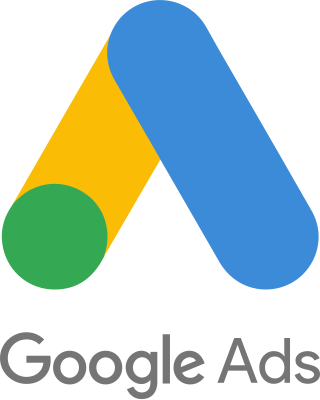Related Research Articles
Digital display advertising is online graphic advertising through banners, text, images, video, and audio. The main purpose of digital display advertising is to post company ads on third-party websites. A display ad is usually interactive, which allows brands and advertisers to engage deeper with the users. A display ad can also be a companion ad for a non-clickable video ad.
Affiliate marketing is a marketing arrangement in which affiliates receive a commission for each visit, signup or sale they generate for a merchant. This arrangement allows businesses to outsource part of the sales process. It is a form of performance-based marketing where the commission acts as an incentive for the affiliate; this commission is usually a percentage of the price of the product being sold, but can also be a flat rate per referral.
Google AdSense is a program run by Google through which website publishers in the Google Network of content sites serve text, images, video, or interactive media advertisements that are targeted to the site content and audience. These advertisements are administered, sorted, and maintained by Google. They can generate revenue on either a per-click or per-impression basis. Google beta-tested a cost-per-action service, but discontinued it in October 2008 in favor of a DoubleClick offering. In Q1 2014, Google earned US$3.4 billion, or 22% of total revenue, through Google AdSense. In 2021, more than 38 million websites used AdSense. It is a participant in the AdChoices program, so AdSense ads typically include the triangle-shaped AdChoices icon. This program also operates on HTTP cookies.

Google Ads is an online advertising platform developed by Google, where advertisers bid to display brief advertisements, service offerings, product listings, and videos to web users. It can place ads in the results of search engines like Google Search, mobile apps, videos, and on non-search websites. Services are offered under a pay-per-click (PPC) pricing model.
Click fraud is a type of fraud that occurs on the Internet in pay per click (PPC) online advertising. In this type of advertising, the owners of websites that post the ads are paid based on how many site visitors click on the ads. Fraud occurs when a person, automated script, computer program or an auto clicker imitates a legitimate user of a web browser, clicking on such an ad without having an actual interest in the target of the ad's link in order to increase revenue. Click fraud is the subject of some controversy and increasing litigation due to the advertising networks being a key beneficiary of the fraud.

Yahoo! Native is a native "Pay per click" Internet advertising service provided by Yahoo.
Pay-per-click (PPC) is an internet advertising model used to drive traffic to websites, in which an advertiser pays a publisher when the ad is clicked.
An online advertising network or ad network is a company that connects advertisers to websites that want to host advertisements. The key function of an ad network is an aggregation of ad supply from publishers and matching it with the advertiser's demand. The phrase "ad network" by itself is media-neutral in the sense that there can be a "Television Ad Network" or a "Print Ad Network", but is increasingly used to mean "online ad network" as the effect of aggregation of publisher ad space and sale to advertisers is most commonly seen in the online space. The fundamental difference between traditional media ad networks and online ad networks is that online ad networks use a central ad server to deliver advertisements to consumers, which enables targeting, tracking and reporting of impressions in ways not possible with analog media alternatives.
Online advertising, also known as online marketing, Internet advertising, digital advertising or web advertising, is a form of marketing and advertising that uses the Internet to promote products and services to audiences and platform users. Online advertising includes email marketing, search engine marketing (SEM), social media marketing, many types of display advertising, and mobile advertising. Advertisements are increasingly being delivered via automated software systems operating across multiple websites, media services and platforms, known as programmatic advertising.
Click-through rate (CTR) is the ratio of clicks on a specific link to the number of times a page, email, or advertisement is shown. It is commonly used to measure the success of an online advertising campaign for a particular website, as well as the effectiveness of email campaigns.
Search engine marketing (SEM) is a form of Internet marketing that involves the promotion of websites by increasing their visibility in search engine results pages (SERPs) primarily through paid advertising. SEM may incorporate search engine optimization (SEO), which adjusts or rewrites website content and site architecture to achieve a higher ranking in search engine results pages to enhance pay per click (PPC) listings and increase the Call to action (CTA) on the website.
Contextual advertising is a form of targeted advertising for advertisements appearing on websites or other digital platforms, such as content displayed in mobile browsers. Contextual targeting involves the use of linguistic factors to control the placement of advertising material. The advertisements are selected and delivered by automated systems, taking into consideration the context of a user's search or browsing behaviour. As advertisers and marketers increasingly prioritise brand safety and suitability, contextual advertising has emerged as a crucial aspect in safeguarding the reputation and value of a brand.

Microsoft Advertising is an online advertising platform developed by Microsoft, where advertisers bid to display brief ads, service offers, product listings and videos to web users. Provides pay per click advertising on search engines Bing, Yahoo! and DuckDuckGo, as well as on other websites, mobile apps, and videos.
In Internet marketing, search advertising is a method of placing online advertisements on web pages that show results from search engine queries. Through the same search-engine advertising services, ads can also be placed on Web pages with other published content.

Targeted advertising is a form of advertising, including online advertising, that is directed towards an audience with certain traits, based on the product or person the advertiser is promoting.
Quality Score is a metric used by Google, Yahoo!, Facebook and Bing that influences the ad rank and cost per click (CPC) of ads.
A supply-side platform (SSP) or sell-side platform is a technology platform to enable web publishers and digital out-of-home (DOOH) media owners to manage their advertising inventory, fill it with ads, and receive revenue. Many of the larger web publishers of the world use a supply-side platform to automate and optimize the selling of their online media space.
A demand-side platform (DSP) is a concept that combines various software for advertisers to automate the process of buying and selling ad impressions in real time.
Ad fraud is concerned with the practice of fraudulently representing online advertisement impressions, clicks, conversion or data events in order to generate revenue. Ad-frauds are particularly popular among cybercriminals.
Taboola, Inc. is a publicly traded advertising and technology company headquartered in New York City. It provides "content recommendation" adverts on its partner websites.
References
- ↑ Danny Sullivan (May 13, 2008). "More Than Half Of Yahoo's Paid Search Clicks Come From Partners". Search Enbgine Land. Retrieved September 30, 2015.
- ↑ James Green (April 16, 2012). "Search Beyond Search Engines Can Yield Valuable Data For Advertisers". Marketing Land. Retrieved September 30, 2015.
- ↑ "Mamma.com". Archived from the original on July 12, 2012. Retrieved September 30, 2015.
- ↑ "Microsoft & Yahoo! Search Alliance". Microsoft Advertising. January 2011. Archived from the original on May 14, 2011. Retrieved September 30, 2015.
- 1 2 3 Laurie Sullivan (December 13, 2011). "Search's Stepchild, Syndication, Should Evolve". MediaPost. Retrieved September 30, 2015.
- ↑ Laurie Sullivan (December 13, 2011). "Search Marketers Demand Better Syndication Analytics". MediaPost. Retrieved September 30, 2015.
- ↑ Christopher Heine (January 26, 2012). "Yahoo Search, Display Revenues Dip in Q4 2011". Search Engine Watch. Retrieved September 30, 2015.
- ↑ "Search Syndication and Traffic Quality". May 12, 2008. Archived from the original on January 25, 2012. Retrieved September 30, 2015.
- ↑ Robert Hof (January 19, 2012). "Google's Q4 Revenues Miss Forecasts, Stock Falls 9%". Forbes. Retrieved September 30, 2015.
- ↑ Wendy Davis (February 22, 2010). "Search Marketer Files Antitrust Lawsuit Against Google". MediaPost. Retrieved September 30, 2015.
- ↑ Katy Bachman (January 26, 2012). "Lobby Aimed at Google's Dominance Broadens Membership New ad campaign attacks search firm's control on the Web". Adweek. Retrieved September 30, 2015.
- ↑ Laurie Sullivan (January 3, 2012). "Post-Conversion Data Generates CreditCards.com Ads High Returns". MediaPost. Retrieved September 30, 2015.
- ↑ George Michie (March 1, 2010). "Yah Hoo for Yahoo!". Merkle/RKG. Retrieved September 30, 2015.
- ↑ George Michie (July 31, 2007). "Click Fraud and Search Syndication Networks: What you don't know can Hurt you!". Merkle/RKG. Retrieved September 30, 2015.
- ↑ Michael Rovner (October 28, 2011). "adMarketplace Delivers Accountability Syndicated search for the world beyond Google, Yahoo and Bing" . Retrieved September 30, 2015.